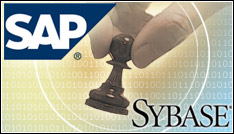Following SAP’s acquisition of mobile-technology provider Sybase, some have been wondering how the deal is going to affect the company’s mobile strategy going forward. While SAP executives are remaining close-lipped about the deal itself, and their intentions with Sybase’s assets, at least one was willing to talk to eWEEK about SAP’s mobile philosophy with regard to burgeoning platforms such as Google Android and the Apple iPhone.
“In the past 18 months, what we’ve been noticing is that device-specific experiences are the ones getting huge amounts of adoption,” George Mathew, SAP’s general vice president and general manager for Business Intelligence & In-Memory Analytics, said during a July 22 interview with eWEEK. “There is a real compelling strategy for us to create a minimum baseline for how BI content is more actively shared between devices; that’s the starting point for creating device-specific experiences.”
Sybase acquisition
 SAP’s $5.8 billion acquisition of Sybase, announced May 12, was widely regarded as the start of a major shift in the enterprise-software landscape. In addition to allowing SAP to stay competitive with Oracle via new revenue streams, it also opened the door for the company to consolidate and expand its mobile offerings via Sybase’s mobile technology.
SAP’s $5.8 billion acquisition of Sybase, announced May 12, was widely regarded as the start of a major shift in the enterprise-software landscape. In addition to allowing SAP to stay competitive with Oracle via new revenue streams, it also opened the door for the company to consolidate and expand its mobile offerings via Sybase’s mobile technology.
“On first glance, this is clearly a strength-to-weakness deal. SAP’s annual sales and its market cap are both [more than 10] times the size of Sybase’s,” Pund-IT Research analyst Charles King wrote in a 13 May research note. “While SAP develops and delivers a wide range of enterprise business software solutions, Sybase’s offerings are skewed towards the global mobile market.”
The deal also marked the largest acquisition for SAP since its $6.7 billion (£4.3bn) purchase of business intelligence software producer BusinessObjects in 2008. Sybase had been an SAP strategic partner prior to the deal. When creating previous applications for BlackBerry, SAP had previously layered functionality atop a Sybase platform; if and when the acquisition is completed, Mathew suggested, functionality and platform will be consolidated under one roof.
Mathew has noted a number of businesses incorporating both the iPhone and the iPad into their IT mobile infrastructure; to capitalise on that, SAP created a BusinessObjects Explorer for the iPhone, which Mathew claims had 80,000 downloads since its release. “We’re seeing an uptick for the iPad-optimised version,” he said. “Now that we’re seeing adoption of Android devices into the enterprise, we’re going to be looking at a similar investment.”
Holding out on Windows 7
When asked about the upcoming Windows Phone 7, though, Mathew seemed to take more of a wait-and-see approach. “It’s the same way I felt about Android last year,” he said. “I knew there were compelling reasons why it would make sense to invest in Android, but I was holding until there was reasonable momentum. Once there’s factual evidence about the market, then you’re able to move quickly.”
Even for larger companies such as SAP, then, it seems to come down to careful use of developer resources. “It’s not a question of how quickly you can build a mobile app,” Mathew said, “it’s about being judicious about where you make your investments. I’d rather make the ones for well-adapted devices.”




